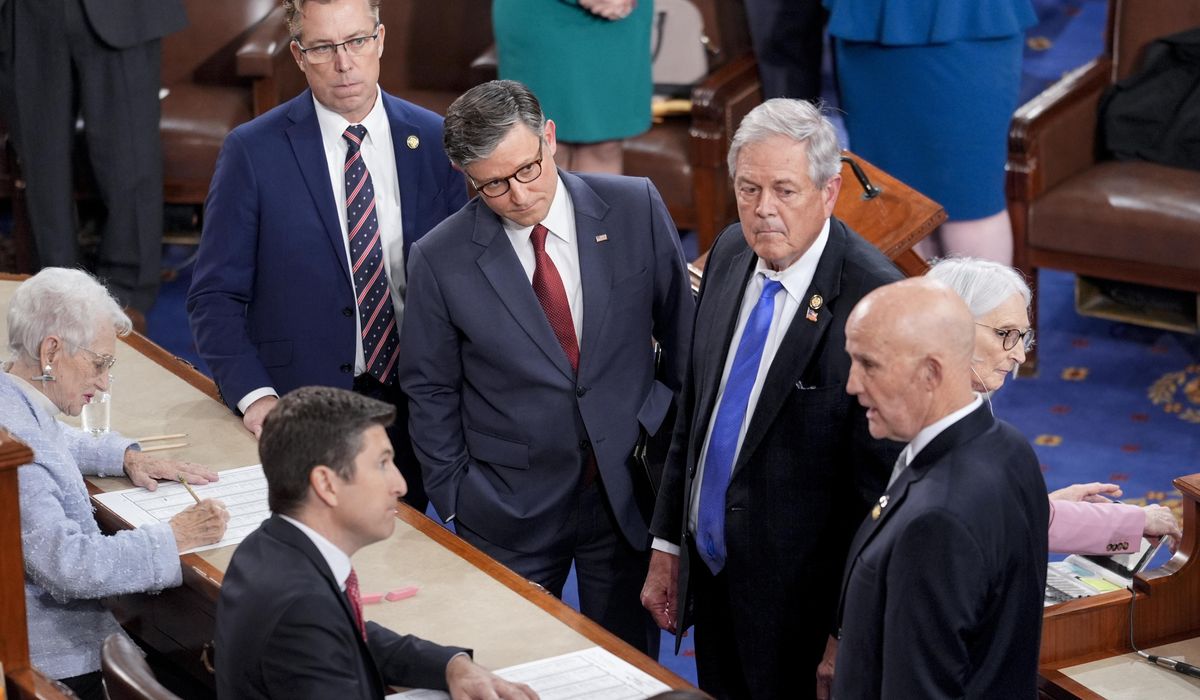


The House Freedom Caucus released its own budget blueprint Monday, including a proposed $4 trillion increase in the debt limit, as the broader House Republican Conference struggles to coalesce around a plan.
The proposal from the conservative hardliners diverges from House GOP leaders’ approach in that it seeks to separate President Trump’s agenda into two budget reconciliation bills, instead of one giant package. It’s similar to a budget resolution Senate Republicans released last week but it offers far more spending cuts, as well as the debt-limit increase the president has sought.
The Freedom Caucus’ goal is to provide a surge of funding for border security and defense needs, while slashing spending in other areas. Their two-track budget reconciliation plan, like one concocted by Senate Republicans, would save a more complicated tax overhaul for a second bill to come later in the year before tax cuts enacted during Mr. Trump’s first term expire.
Adopting a budget resolution is the first step in the budget reconciliation process, which would allow Republicans to pass the bulk of Mr. Trump’s legislative priorities without the threat of a Democratic filibuster in the Senate.
House Republicans have spent weeks negotiating a budget resolution to tee up “one big beautiful bill” that includes trillions of dollars worth of tax cuts, but have yet to reach agreement on how far to go to cut spending in the process.
The internal discord has led to delays in scheduling a committee markup of the budget resolution, which Speaker Mike Johnson had said would occur last week, then this week, and now maybe later.
“We might push it a little bit further because the details really matter,” Mr. Johnson, Louisiana Republican, said on “Fox News Sunday,” citing his narrow House majority. “So I’ve got to make sure everyone agrees before we bring the [budget resolution] forward … We’ve got a few more boxes to check, but we’re getting very, very close.”
Senate Republicans, frustrated by the delay in the House, are moving forward with their own budget resolution in a two-day committee markup on Wednesday and Thursday.
The Freedom Caucus plan is also designed to move the process forward. Rep. Andy Harris, Maryland Republican and the group’s chairman, said Congress “must rapidly” provide the president and his administration the funding they need to stop illegal border crossings and deport undocumented immigrants.
“Given the current delay in the House on moving a comprehensive reconciliation bill, moving a smaller targeted bill now makes the most sense to deliver a win for the president and the American people,” Mr. Harris said.
The Freedom Caucus’ budget resolution would allow for up to $200 billion in new spending over four years: $100 billion for border security and immigration enforcement and $100 billion for defense.
That’s less than the $345 billion the Senate budget resolution would authorize for both categories over the same period.
The Freedom Caucus plan also calls for more offsetting spending cuts than the Senate did.
The conservative hardliners are asking committees of jurisdiction to collectively come up with at least $486 billion worth of spending cuts over 10 years, which after accounting for the new spending, would result in net deficit reduction of at least $286 billion.
The Senate budget plan sets a floor of $5 billion in deficit reduction to give committees flexibility, but Republicans in the upper chamber said their plan is to fully offset the $345 billion in new spending their plan anticipates.
The Freedom Caucus budget also includes instructions for the $4 trillion increase in the statutory debt limit. The fiscal hawks in the caucus typically would not support a debt-limit increase but would prefer to address the issue in a party-line bill alongside spending cuts than have Republican leaders cut a deal with Democrats.
Congress needs to raise the debt limit by this summer to prevent the government from defaulting on its borrowing obligations.
The Washington Times reached out to the speaker’s office for comment on the Freedom Caucus proposal.
Mr. Johnson and Senate Budget Chairman Lindsey Graham, the architect of his chamber’s two-track budget reconciliation plan, talked Sunday night while attending the Super Bowl with the president.
The speaker told reporters on Monday that the House and Senate “are not at odds,” and that he took a picture with Mr. Graham where they both held up one finger to represent “one beautiful bill.”
“And he smiled,” Mr. Johnson said of Mr. Graham. “There is no daylight between us. We all want exactly the same thing. … But they want to move and show some action. So, I get that.”
Mr. Graham, South Carolina Republican, posted on X that the speaker is right in that his “preference” is one bill that would make the tax cuts from Mr. Trump’s first term permanent along with funding the border security and defense needs — “but reality is something altogether different.”
The Homeland Security Department does not have the funding it needs to finish construction of the border wall, hire more Immigration and Customs Enforcement agents to round up and deport illegal immigrants and expand detention bed space, Mr. Graham said.
“The money is drying up,” he said, noting his budget resolution provides for $175 billion to secure the border, “the exact amount requested by the Trump team.”
• Lindsey McPherson can be reached at lmcpherson@washingtontimes.com.
